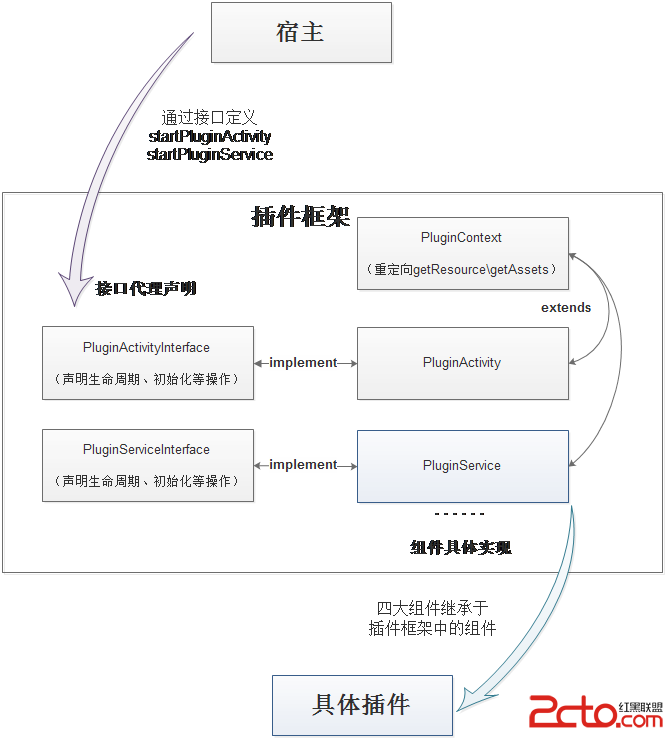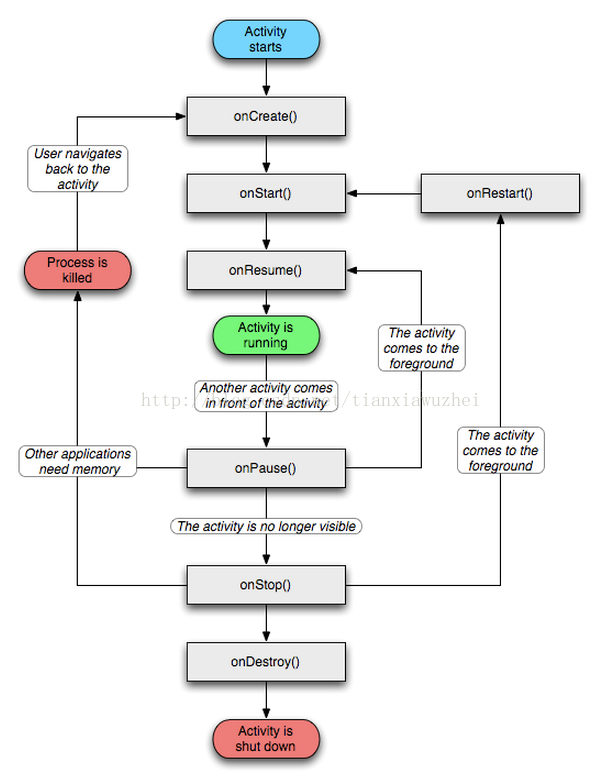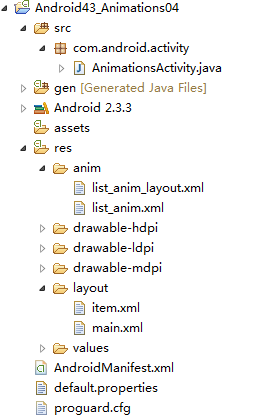編輯:關於Android編程
一.需求分析:
1.通過按Android平板(或手機)的物理按鍵(如音量鍵)實現Activity界面的跳轉;以前基本是自己寫控件進行跳轉啊!
2.按音量減鍵跳轉:界面1到界面2,2到3,3到4,4到5,5到1;按音量加鍵跳轉:1到5,5到4,4到3,3到2,2到1。
五個界面顏色1:白色,2:黑色,3:紅,4:綠,5:藍。 目的是用來進行屏的測試。
二、直接上代碼
1.五個類的代碼
Launcher1:
package com.zhc.launcher;
import android.annotation.SuppressLint;
import android.app.Activity;
import android.content.Intent;
import android.os.Bundle;
import android.util.Log;
import android.view.KeyEvent;
import android.view.View;
import android.view.Window;
import android.view.WindowManager;
public class Launcher1 extends Activity implements KeyEvent.Callback {
private static final String TAG = "Launcher";
@SuppressLint("NewApi")
@Override
protected void onCreate(Bundle savedInstanceState) {
super.onCreate(savedInstanceState);
// 1.隱藏標題欄
requestWindowFeature(Window.FEATURE_NO_TITLE);
// 2.隱藏狀態欄
getWindow().setFlags(WindowManager.LayoutParams.FLAG_FULLSCREEN,
WindowManager.LayoutParams.FLAG_FULLSCREEN);
// 3.隱藏導航欄和狀態欄
View decorView = getWindow().getDecorView();
int uiOptions = View.SYSTEM_UI_FLAG_HIDE_NAVIGATION
| View.SYSTEM_UI_FLAG_FULLSCREEN;
decorView.setSystemUiVisibility(uiOptions);
setContentView(R.layout.activity_one);
}
// 4. 攔截系統熱鍵
@Override
public boolean dispatchKeyEvent(KeyEvent event) {
int key = event.getKeyCode();//獲取物理按鍵的key類型:比如音量鍵,power鍵等
int key1 = event.getAction();//獲取某一物理按鍵的對應的事件類型;比如音量鍵的按下(down)事件,音量鍵的松開(up)事件
if (key == KeyEvent.KEYCODE_DPAD_LEFT
|| key == KeyEvent.KEYCODE_VOLUME_UP) {//按下的是安卓物理左鍵或者是音量鍵上鍵
if (key1 == KeyEvent.ACTION_UP) {//音量鍵上鍵的up事件
Log.i(TAG, "1");
Intent intentright = new Intent(Launcher1.this, Launcher5.class);
startActivity(intentright);
return true;
}
} else if (key == KeyEvent.KEYCODE_DPAD_RIGHT
|| key == KeyEvent.KEYCODE_VOLUME_DOWN) {//按下的是安卓物理右鍵或者是音量鍵下鍵
if (key1 == KeyEvent.ACTION_UP) {//音量鍵下鍵的up事件
Log.i(TAG, "2");
Intent intentright = new Intent(Launcher1.this, Launcher2.class);
startActivity(intentright);
return true;
}
}
return super.dispatchKeyEvent(event);
}
}
Launcher2:
package com.zhc.launcher;
import android.annotation.SuppressLint;
import android.app.Activity;
import android.content.Intent;
import android.os.Bundle;
import android.util.Log;
import android.view.KeyEvent;
import android.view.View;
import android.view.Window;
import android.view.WindowManager;
public class Launcher2 extends Activity {
private static final String TAG = "Launcher2";
@SuppressLint("NewApi")
@Override
protected void onCreate(Bundle savedInstanceState) {
super.onCreate(savedInstanceState);
// 1.隱藏標題欄
requestWindowFeature(Window.FEATURE_NO_TITLE);
// 2.隱藏狀態欄
getWindow().setFlags(WindowManager.LayoutParams.FLAG_FULLSCREEN,
WindowManager.LayoutParams.FLAG_FULLSCREEN);
// 3.隱藏導航欄和狀態欄
View decorView = getWindow().getDecorView();
int uiOptions = View.SYSTEM_UI_FLAG_HIDE_NAVIGATION
| View.SYSTEM_UI_FLAG_FULLSCREEN;
decorView.setSystemUiVisibility(uiOptions);
setContentView(R.layout.activity_two);
}
// 攔截系統熱鍵
@Override
public boolean dispatchKeyEvent(KeyEvent event) {
int key = event.getKeyCode();// 獲取物理按鍵的key類型:比如音量鍵,power鍵等
int key1 = event.getAction();// 獲取某一物理按鍵的對應的事件類型;比如音量鍵的按下(down)事件,音量鍵的松開(up)事件
if (key == KeyEvent.KEYCODE_DPAD_LEFT
|| key == KeyEvent.KEYCODE_VOLUME_UP) {// 按下的是安卓物理左鍵或者是音量鍵上鍵
if (key1 == KeyEvent.ACTION_UP) {// 音量鍵上鍵的up事件
Log.i(TAG, "1");
Intent intentright = new Intent(Launcher2.this, Launcher1.class);
startActivity(intentright);
return true;
}
} else if (key == KeyEvent.KEYCODE_DPAD_RIGHT
|| key == KeyEvent.KEYCODE_VOLUME_DOWN) {// 按下的是安卓物理右鍵或者是音量鍵下鍵
if (key1 == KeyEvent.ACTION_UP) {// 音量鍵下鍵的up事件
Log.i(TAG, "2");
Intent intentright = new Intent(Launcher2.this, Launcher3.class);
startActivity(intentright);
return true;
}
}
return super.dispatchKeyEvent(event);
}
}
Launcher3:
package com.zhc.launcher;
import android.annotation.SuppressLint;
import android.app.Activity;
import android.content.Intent;
import android.os.Bundle;
import android.util.Log;
import android.view.KeyEvent;
import android.view.View;
import android.view.Window;
import android.view.WindowManager;
public class Launcher3 extends Activity {
private static final String TAG = "Launcher3";
@SuppressLint("NewApi")
@Override
protected void onCreate(Bundle savedInstanceState) {
super.onCreate(savedInstanceState);
// 1.隱藏標題欄
requestWindowFeature(Window.FEATURE_NO_TITLE);
// 2.隱藏狀態欄
getWindow().setFlags(WindowManager.LayoutParams.FLAG_FULLSCREEN,
WindowManager.LayoutParams.FLAG_FULLSCREEN);
// 3.隱藏導航欄和狀態欄
View decorView = getWindow().getDecorView();
int uiOptions = View.SYSTEM_UI_FLAG_HIDE_NAVIGATION
| View.SYSTEM_UI_FLAG_FULLSCREEN;
decorView.setSystemUiVisibility(uiOptions);
setContentView(R.layout.activity_three);
}
// 攔截系統熱鍵
@Override
public boolean dispatchKeyEvent(KeyEvent event) {
int key = event.getKeyCode();// 獲取物理按鍵的key類型:比如音量鍵,power鍵等
int key1 = event.getAction();// 獲取某一物理按鍵的對應的事件類型;比如音量鍵的按下(down)事件,音量鍵的松開(up)事件
if (key == KeyEvent.KEYCODE_DPAD_LEFT
|| key == KeyEvent.KEYCODE_VOLUME_UP) {// 按下的是安卓物理左鍵或者是音量鍵上鍵
if (key1 == KeyEvent.ACTION_UP) {// 音量鍵上鍵的up事件
Log.i(TAG, "1");
Intent intentright = new Intent(Launcher3.this, Launcher2.class);
startActivity(intentright);
return true;
}
} else if (key == KeyEvent.KEYCODE_DPAD_RIGHT
|| key == KeyEvent.KEYCODE_VOLUME_DOWN) {// 按下的是安卓物理右鍵或者是音量鍵下鍵
if (key1 == KeyEvent.ACTION_UP) {// 音量鍵下鍵的up事件
Log.i(TAG, "2");
Intent intentright = new Intent(Launcher3.this, Launcher4.class);
startActivity(intentright);
return true;
}
}
return super.dispatchKeyEvent(event);
}
}
Launcher4:
package com.zhc.launcher;
import android.annotation.SuppressLint;
import android.app.Activity;
import android.content.Intent;
import android.os.Bundle;
import android.util.Log;
import android.view.KeyEvent;
import android.view.View;
import android.view.Window;
import android.view.WindowManager;
public class Launcher4 extends Activity {
private static final String TAG = "Launcher4";
@SuppressLint("NewApi")
@Override
protected void onCreate(Bundle savedInstanceState) {
super.onCreate(savedInstanceState);
// 1.隱藏標題欄
requestWindowFeature(Window.FEATURE_NO_TITLE);
// 2.隱藏狀態欄
getWindow().setFlags(WindowManager.LayoutParams.FLAG_FULLSCREEN,
WindowManager.LayoutParams.FLAG_FULLSCREEN);
// 3.隱藏導航欄和狀態欄
View decorView = getWindow().getDecorView();
int uiOptions = View.SYSTEM_UI_FLAG_HIDE_NAVIGATION
| View.SYSTEM_UI_FLAG_FULLSCREEN;
decorView.setSystemUiVisibility(uiOptions);
setContentView(R.layout.activity_four);
}
// 攔截系統熱鍵
@Override
public boolean dispatchKeyEvent(KeyEvent event) {
int key = event.getKeyCode();// 獲取物理按鍵的key類型:比如音量鍵,power鍵等
int key1 = event.getAction();// 獲取某一物理按鍵的對應的事件類型;比如音量鍵的按下(down)事件,音量鍵的松開(up)事件
if (key == KeyEvent.KEYCODE_DPAD_LEFT
|| key == KeyEvent.KEYCODE_VOLUME_UP) {// 按下的是安卓物理左鍵或者是音量鍵上鍵
if (key1 == KeyEvent.ACTION_UP) {// 音量鍵上鍵的up事件
Log.i(TAG, "1");
Intent intentright = new Intent(Launcher4.this, Launcher3.class);
startActivity(intentright);
return true;
}
} else if (key == KeyEvent.KEYCODE_DPAD_RIGHT
|| key == KeyEvent.KEYCODE_VOLUME_DOWN) {// 按下的是安卓物理右鍵或者是音量鍵下鍵
if (key1 == KeyEvent.ACTION_UP) {// 音量鍵下鍵的up事件
Log.i(TAG, "2");
Intent intentright = new Intent(Launcher4.this, Launcher5.class);
startActivity(intentright);
return true;
}
}
return super.dispatchKeyEvent(event);
}
}
Launcher5:
package com.zhc.launcher;
import android.annotation.SuppressLint;
import android.app.Activity;
import android.content.Intent;
import android.os.Bundle;
import android.util.Log;
import android.view.KeyEvent;
import android.view.View;
import android.view.Window;
import android.view.WindowManager;
public class Launcher5 extends Activity {
private static final String TAG = "Launcher5";
@SuppressLint("NewApi")
@Override
protected void onCreate(Bundle savedInstanceState) {
super.onCreate(savedInstanceState);
// 1.隱藏標題欄
requestWindowFeature(Window.FEATURE_NO_TITLE);
// 2.隱藏狀態欄
getWindow().setFlags(WindowManager.LayoutParams.FLAG_FULLSCREEN,
WindowManager.LayoutParams.FLAG_FULLSCREEN);
// 3.隱藏導航欄和狀態欄
View decorView = getWindow().getDecorView();
int uiOptions = View.SYSTEM_UI_FLAG_HIDE_NAVIGATION
| View.SYSTEM_UI_FLAG_FULLSCREEN;
decorView.setSystemUiVisibility(uiOptions);
setContentView(R.layout.activity_five);
}
// 攔截系統熱鍵
@Override
public boolean dispatchKeyEvent(KeyEvent event) {
int key = event.getKeyCode();// 獲取物理按鍵的key類型:比如音量鍵,power鍵等
int key1 = event.getAction();// 獲取某一物理按鍵的對應的事件類型;比如音量鍵的按下(down)事件,音量鍵的松開(up)事件
if (key == KeyEvent.KEYCODE_DPAD_LEFT
|| key == KeyEvent.KEYCODE_VOLUME_UP) {// 按下的是安卓物理左鍵或者是音量鍵上鍵
if (key1 == KeyEvent.ACTION_UP) {// 音量鍵上鍵的up事件
Log.i(TAG, "1");
Intent intentright = new Intent(Launcher5.this, Launcher4.class);
startActivity(intentright);
return true;
}
} else if (key == KeyEvent.KEYCODE_DPAD_RIGHT
|| key == KeyEvent.KEYCODE_VOLUME_DOWN) {// 按下的是安卓物理右鍵或者是音量鍵下鍵
if (key1 == KeyEvent.ACTION_UP) {// 音量鍵下鍵的up事件
Log.i(TAG, "2");
Intent intentright = new Intent(Launcher5.this, Launcher1.class);
startActivity(intentright);
return true;
}
}
return super.dispatchKeyEvent(event);
}
}
3.清單文件
 android 集成系統分享和第三方分享案例
android 集成系統分享和第三方分享案例
現在很多的應用基本都會集成分享這個功能,該功能包括系統分享(比如郵件,短信)和第三方分享(比如QQ和微信)。其中有些公司會選擇使用第三方的庫來簡化這些操作,加快開發,用的
 Android插件開發初探——分析篇
Android插件開發初探——分析篇
我們通過使用DexClassLoader能夠將classes.dex中的類動態的加載進入當前進程。當然,也就可以預先定一些代理的接口完成四大組件的功能。整體功
 cocos2dx-2.X前後台切換分析,基於android平台
cocos2dx-2.X前後台切換分析,基於android平台
摘自網上的android生命周期圖: cocos2dx-2.X前後台切換分析,基於android平台:1、從後台進入前台項目的activity一般繼承自Coco
 Android編程之Animation動畫詳解
Android編程之Animation動畫詳解
本文實例講述了Android編程之Animation動畫用法。分享給大家供大家參考,具體如下:Animations一、Animations介紹Animations是一個實